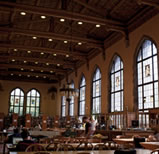Searching by Subject Heading
Library of Congress subject headings are a set of standardized terms used to describe book topics in virtually all research university libraries. They can be very helpful in locating books on a particular topic in NUsearch, WorldCat, or any other university catalog.
Here are examples of two very general and two very specific art subject headings, which might be useful in designing your own search terms:
- Architecture -- Illinois -- Chicago
- Architecture, Modern -- 20th century
- Hadid, Zaha -- Exhibitions
- Architecture, Prehistoric -- Textbooks
You can look at any library catalog record or sometimes in the front matter of published books for other relevant subject headings.
Call Numbers
Call numbers tell you where you can find a book on a library shelf. There are two call number systems in use at Northwestern University Libraries:
Both systems arrange items by subject so that library materials on similar subjects are shelved or grouped together.
This Northwestern guide explains why we use two systems at NUL and gives detailed instructions for finding books in both systems.
Dewey Decimal Call Numbers
720 Architecture
721 Architectural structure
722 Architecture to ca. 300
723 Architecture from ca. 300 to 1399
724 Architecture from 1400
725 Public structures
726 Buildings for religious purposes
727 Buildings for education & research
728 Residential & related buildings
729 Design & decoration
Library of Congress Call Numbers
NA Architecture
NA 1-60 General
NA 100-130 Architecture and the state
NA 190-1555.5 History
NA 1995 Architecture as a profession
NA 2000-2320 Study and teaching.
Research
NA 2335-2360 Competitions
NA 2400-2460 Museums. Exhibitions
NA 2500-2599 General works
NA 2599.5-2599.9 Architectural criticism
NA 2695-2793 Architectural drawing
and design
NA 2835-4050 Details and decoration
NA 4100-8480 Special classes of buildings
NA 4100-4145 Classed by material
NA 4150-4160 Classed by form
NA 4170-8480 Classed by use
NA 4170-(7020) Public buildings
NA 4590-5621 Religious architecture
NA 7100-7884 Domestic architecture.
Houses. Dwellings
NA 7910-8125 Clubhouses, guild houses,
etc.
NA 8200-8260 Farm architecture
NA 8300-8480 Outbuildings, gates,
fences, etc.
NA 9000-9428 Aesthetics of cities.
City planning
and beautifying
Where to Look
You will find books for your topic via personal recommendations, in reference sources, by browsing in the library and its catalogs, and in the footnotes and bibliographies of articles and other books on your topic.
Northwestern University's Art Library collects materials on art, architecture, design, photography, and related visual arts. The collection is especially strong on 19th- and 20th-century Western art, and it contains many rare periodicals on the history of architecture.

- Some materials are housed in the Art Library's Martin Reading Room and its Architecture Reading Room on the third floor of Deering Library
- Other books are housed in the Library's offsite high-density storage facility, Oak Grove
- Rare and valuable architecture books, manuscripts, archival materials, and other primary sources are housed in the special collections library
- Books on architecture in Africa are housed in the Herskovits Library of African Studies
All titles are cataloged in WorldCat and Northwestern's NUsearch library catalog search tool.
You can use NUsearch and WorldCat to find books you already know about (those cited in bibliographies and footnotes from reference sources and articles you've found on your topic), or you can browse them to find new, unknown books that may be useful for topic.
NUsearch catalogs materials found at or available through Northwestern University Libraries;
WorldCat catalogs materials found at libraries all over the world.
Finding a Book at the Library: AKA Using NUsearch
This video will show you how to find and request a book from the library.
1:41
I Just Want to Look Around! AKA Browsing NUsearch
This video will show you how to use NUsearch to browse for materials by topic or author.
2:11
More NUsearch tips
Sign in to NUsearch using you netID and password to save the records you find for interesting books. Once you have collected a list of library books you would like to see, make a note of where they are located.
Books and serials in the Architecture collection are shelved in the Architecture Reading Room according to size. There are three Dewey Decimal call number sequences and three Library of Congress sequences for differently sized books: Regular, Large (L), and Folio (F). For books located in the Architecture Reading Room, come to the third (top) floor of Deering Library where you can browse the reading room's open stacks to find the materials you need.
If your books are stored in the library's offsite Oak Grove storage facility, place a request for them through NUsearch (you must be logged in with your netID and usual password to do this) and the books will be delivered to the University Library's main circulation desk for you.